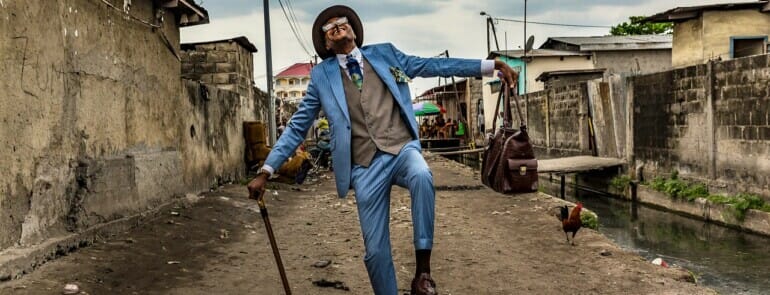THE ART OF LA SAPE
A La Sape enthusiast is called a Sapeur and the movement is called Sapeurism (La Sapologe). La Sape is an abbreviation based on the phrase Société des Ambianceurs et des Personnes Élégantes (loosely translated to Society of Ambiance-Makers and Elegant People). Sapeurism is a cult-like love for extravagant fashion and style amongst the – mostly poor – males inhabiting Kinshasa in the DR Congo and Brazzaville in the Republic of Congo. It started during the time of slavery around the 1920s where African workers would be paid in clothes by their colonial dandies, and in a bid to mock their ‘masters’ opted to wear them with an exaggerated level of radiance, elegance, confidence and style.

By the 1930s, these workers, now earning meagre wages would use almost every penny to import extravagant looking clothing from France as a definition of their personal style and by the 1950s and 60s Sapeurism had become a subculture promoted even further by the booming lingala music culture. The decolonisation of Zaire from Belgium saw president Mbutu Seke Seso enforce Africanisation and ban any form of ‘western clothing’. This created a cultural upheaval by the Sapeurs which is when they really rose to glory. They were persecuted for wearing suits and in response ‘weaponised’ that which they wear as a form of personal empowerment. By that time, it stopped being just about the brightly coloured suits, crocodile skin shoes and eclectic print bowties, it became a philosophy, a way of life.

Sapeurism is believed to be an elegance that brought peace and contentment amidst the chaos and lack of poverty-stricken regions of Kinshasa and Brazzaville. According to the World Bank, 46.5% of Congolese live at or below the national poverty line and the country’s per capita gross national income is $3,240. Yet, it is not uncommon to find Sapeurs spending up to US$ 5,000 on a suit of US$ 2,000 on a pair of shoes. But for them, it is worth it because when he steps out of the house, the dusty polluted street becomes his runway, walking with exaggerated confidence he beacons admiration and wonder from everyone around him.

Today, Sapeurism has taken on a new level of style, sophistication and extravagance. Sapeurs have an heir of celebrity within their towns and villages – and sometimes a level of stigmatisation where they are seen to prioritize clothes and fashion over putting food on their tables. During the week, they are modern day wage earners including taxi drivers, farmers and houseboys, but on the weekend, they turn into overconfident men (of all ages) clad in the brightest of suits for all to see. They also tend to become social butterflies often visiting weddings, funerals and any event that would not necessarily give them a reason to dress up but give them a place to be seen by many.

The La Sape is a highly documented and followed movement across the world, by both fashion enthusiasts and scholars. It highlights an ideology different from any other in any society yet speaks true to the psychology of the human mind in the context of escapism. With modern dress and high fashion penetrating Central Africa is various forms and fashions, they do not stand out nearly as much as they used to, but small pockets of brotherhoods and true ‘Sapeurists’ can still be found in both rural and modern-day Congo and all the way in France as a memoir to their home country.

The Sapeur Way
“Style emerges in four dimensions, dress, music, ritual, and argot, that create both physical and symbolic markers of a subculture. For the sapeur, dress is not merely the clothes one wears but an intentional embodiment of choices and self. Sapeurs have constructed a distinct set of code that explicitly guide the composition of outfits (color scheme, type of clothing articles, etc.) but implicitly inform how sapeurs are to physically move with grace and elegance, behave in a patient and leisurely manner that suggests a peaceful environment, and converse on topics related to aesthetic representations and apolitical subjects to imply they are without discontentment nor worry. Dress is seemingly absent of political or social control and its ubiquitous function in daily life presents an ideal medium in which sapeurs can claim full autonomy. Sapeurs embed value into the designer labels of their clothing, which are not only indicators of high fashion, but quality, history, and the legacy of designers and their artwork. Dress is the essence and driving element of sapologie through which sapeurs find authenticity.” Grennel College, Subcultures and Sociology.

